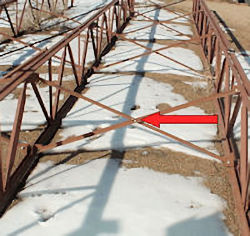Erection Bridging
Where the span of the steel joist is equal to or greater than the span shown in OSHA Standard 1926.757 Tables A and B the following applies:
- A row of bolted diagonal erection bridging must be installed near the mid-span of the steel joist.
- Hoisting cables must not be released until this bolted diagonal erection bridging is installed and anchored.
- No more than one employee is allowed on these spans until all other bridging is installed and anchored.
Where the span of the steel joist is 60 feet through 100 feet, the following applies:
- All rows of bridging must be bolted with diagonal bridging.
- Two rows of bolted diagonal erection bridging must be installed near the third points of the steel joist (e.g. 1/3 joist-length) from each end.
- Hoisting cables must not be released until this bolted diagonal erection bridging is installed and anchored.
- No more than two employees are allowed on these spans until all other bridging is installed and anchored.
Where the span of the steel joist is 100 feet through 144 feet, the following applies:
- All rows of bridging must be bolted with diagonal bridging.
- Hoisting cables must not be released until all bridging is installed and anchored.
- No more than two employees are allowed on these spans until all bridging is installed and anchored.
For steel members spanning more than 144 feet, the erection methods used must be in accordance with 29 CFR 1926.756.
Where any steel joist that requires bridging is a bottom chord bearing joist:
- A row of bolted diagonal bridging must be provided near the supports.
- This bridging must be installed and anchored before the hoisting cables are released.
When bolted diagonal erection bridging is required, the following applies:
- The bridging must be indicated on the erection drawing.
- The erection drawing must be the exclusive indicator of the proper placement of this bridging.
- Shop-installed bridging clips, or functional equivalents, must be used where the bridging bolts to the steel joists.
- When two pieces of bridging are attached to the steel joist by a common bolt, the nut that secures the first piece of bridging must not be removed from the bolt in order to attach the second.
- Bridging attachments must not protrude above the top chord of the steel joist.
Knowledge Check Choose the best answer for the question.
3-13. Where the span of the steel joist is 100 feet through 144 feet, all rows of bridging must _____.
You forgot to answer the question!

